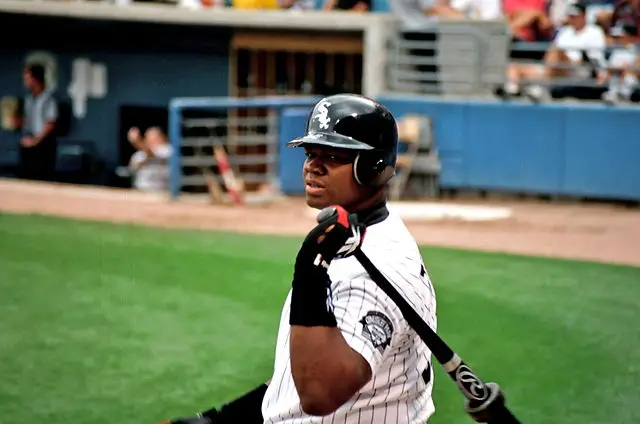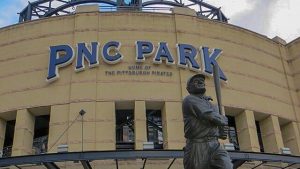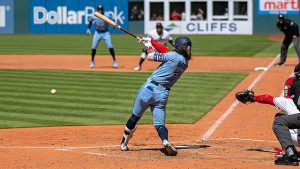Last Updated on October 4, 2023 by Matt Musico
Which players are among the White Sox single season home run leaders at each position? We’ve got the answers (and as many videos as we can find) all in one spot. Outside of pitcher, players at each position had to qualify for the batting title. They also had to play at least 75% of their season at that specific area on the diamond.
Once you’re done here, be sure to also check out our White Sox single-season and all-time home run leaderboards.
Want to see the White Sox slug dingers in person? Grab tickets from our friends at Vivid Seats. And before you get to the stadium, make sure you’re decked out in the right gear. Get official White Sox merch from the MLB Shop or a ‘Big Dinger Energy’ shirt from our apparel store.
White Sox Single Season Home Run Leaders
Catcher: Carlton Fisk, 1985: 37 Home Runs
Carlton Fisk has the honor of being the single-season home run leader at catcher for two teams. In addition to being here for the White Sox, he had previously done it for the Boston Red Sox. This performance in Chicago really stands out, though, and for a number of reasons.
His 37 homers and 107 RBI are both single-season career-high marks. This performance earned him his 10th All-Star Game selection, which was during his age-37 season (!). Fisk produced eight seasons with 20-plus homers, but this was the only time he got over the 30-homer plateau.
Fisk did the majority of his work in the first half, hitting 23 homers with a .528 slugging percentage in 302 plate appearances. He accumulated slightly more trips to the plate in the second half (318), but it was accompanied by 14 homers and a .450 slugging percentage. The backstop hit four homers in each of April and September but didn’t hit fewer than six in any other month. His best performance came in July (nine homers, 23 RBI).
Pitcher: Jack Harshman, 1956: 6 Home Runs
Does Jack Harshman‘s name sound familiar, too? It should. After setting the White Sox record, he did the same thing for the Baltimore Orioles two years later.
In parts of five big-league seasons leading up to 1956, Harshman had slugged six career homers. So, he doubled his career total in just 87 plate appearances. These dingers were joined by a .714 OPS and a single-season career-high 19 RBI.
Harshman also put together a great year on the mound. In 226.1 innings, he went 15-11 with a 3.10 ERA and 1.26 WHIP.
First Base: Frank Thomas (1993) & Paul Konerko (2004): 41 Home Runs
There have been five performances of 40-plus homers by a first baseman in White Sox history. All of them belong to either Frank Thomas (three times) or Paul Konerko (two times).
Thomas’ 1993 performance was the first time he got himself over 40 dingers in one year. He accomplished that feat four other times and was a consistent power threat during his Hall of Fame career. That’s what happens when you hit 521 dingers. But this was the start of his greatest power peak.
Between 1993 and 1997, Thomas never finished with fewer than 35 homers (even with strike-shortened seasons) and hit 40-plus three times. This also included back-to-back AL MVP Awards in 1993 and 1994. Of the 41 dingers he hit in ’93, he slugged 21 of them between July (11) and August (10).
Konerko’s 2004 performance was also the best part of his power peak. It was his first of consecutive 40-homer seasons, the only two times he reached that benchmark. The first baseman did the majority of his damage in front of fans in Chicago.
At home, Konerko hit .317/.414/.666 with 29 homers and 70 RBI in 331 plate appearances. In a similar sample size (312 plate appearances), his numbers dropped to .239/.301/.407 with 12 homers and 47 RBI on the road.
A hot June also put the right-handed slugger on this path. He hit five homers in each of April and May, but then doubled his season-long total in June by slugging 1o dingers.
Second Base: Alexei Ramirez, 2008: 21 Home Runs
If you look around the internet, Juan Uribe‘s 23 home runs in 2004 might be viewed as the single-season franchise record for a second baseman. But he also spent time at shortstop and third base during that year. So much time that he only played at the keystone for 54% of his games played.
Alexei Ramirez, on the other hand, spent 121 of his 136 games played in 2008 at second base, so we’re giving him the honors. Many remember Ramirez as Chicago’s shortstop for a number of years, but his rookie season was mostly spent on the other side of second base.
He posted a .792 OPS with those 21 homers and 77 RBI. This performance led to a second-place finish in AL Rookie of the Year voting. Evan Longoria took home the hardware for the Tampa Bay Rays.
Ramirez’s power didn’t really show itself until the second half, too. By the end of June, he had just five homers to his name. If we look at his first- and second-half splits, they’re similar on the surface, but very different if we go one layer below. His OPS was nearly identical (.791 in the first half, and .793 in the second half). But those first-half numbers included a .312/.332/.459 line, seven homers, and 29 RBI. After the All-Star break, those numbers shifted to .269/.303/.490, 14, and 48, respectively.
Shortstop: Jose Valentin, 2004: 30 Home Runs
When it comes to home runs at shortstop in White Sox history, Jose Valentin is the top dog. And not just once or twice. Three times. Over a five-season span between 2000 and 2004, Valentin posted the three most powerful performances by a shortstop in franchise history.
Valentin’s 2004 production was the final — and best — occurrence of the bunch. These 30 dingers happened in his age-34 campaign. It was the only time he reached that number during his 16-year career, and it was the last time he got over 20. Between 2005 and 2007, Valentin combined to hit 23 homers (including 18 in 2006 for the New York Mets).
His splits were interesting. Valentin hit 18 in the first half and 12 in the second half, but his overall offensive value took a nosedive after the All-Star break. Valentin slashed .254/.325/.548 in the first half, which was followed by a .167/.239/.379 line in the second half.
Third Base: Todd Frazier, 2016: 40 Home Runs
https://www.youtube.com/watch?v=ZzCEtzEc908
Todd Frazier hit a then-career-high 35 homers and won the Home Run Derby at Great American Ball Park in 2015. He landed with the White Sox for the 2016 season and bested that homer number by reaching 40 for the first and only time during his big-league career.
The third baseman slugged 24 of them as a visiting player, but his power numbers were quite consistent when looking at what he did from month to month. Frazier never posted a double-digit homer month but hit fewer than six just once. That happened in August when he slugged four.
He posted an OPS above .800 just once during the season’s first five months (.819 in May), but he saved his best work for last in that department. Over his final 127 plate appearances, Frazier slashed .281/.341/.526 with seven homers and 15 RBI, which led to a .868 OPS.
White Sox Single Season Home Run Leaders
Left Field: Albert Belle, 1998: 49 Home Runs
Albert Belle‘s 49 homers in 1998 aren’t just a franchise record for left fielders. It’s also the highest mark by any White Sox hitter at the moment. Most of Belle’s career was powerful, but this was part of the highest peak of his 12-year MLB career. Between 1995 and 1998, the outfielder slugged at least 48 home runs three (!) times.
His second-half performance is what will always jump out at me. At the All-Star break, Belle had 18 homers off the strength of a .517 slugging percentage. For those who don’t want to do the math at home, 31 of his homers came in the second half while posting a .816 slugging percentage.
Belle’s numbers with runners in scoring position were pretty eye-opening, too. He hit just 14 homers in this situation but also drove in 104 runs while slashing .328/.395/.696.
Center Field: Luis Robert Jr., 2023: 38 Home Runs
Luis Robert Jr. entered this year with 36 career homers across parts of three seasons for the White Sox. It took him 595 plate appearances in 2023 to more than double that number. This was the first campaign Robert appeared in more than 98 games, as well. He played in 145 contests, adding 80 RBI, 90 runs scored, and a .857 OPS to those 38 dingers.
Robert did the majority of his yardwork between May and June. Across just 224 trips to the plate, the outfielder slugged 19 homers with 33 RBI and 43 runs scored, along with a .302/.368/.658 line. You can check out all of his 2023 dingers with our Luis Robert Home Run Tracker.
Right Field: Jermaine Dye, 2006: 44 Home Runs
Between 1996 and 2004, Jermaine Dye had posted just one year of 30-plus homers (33 in 2000 for the Kansas City Royals). Between 2005 and 2009, though, he surpassed that number three times. The best of all was obviously what he did in 2006.
It led to his second and final All-Star Game selection, his only Silver Slugger Award, and a fifth-place finish in AL MVP voting.
The only time Dye hit fewer than six homers in a month was in September. He hit five during that time. The outfielder posted a monthly OPS greater than 1.000 four times in 2006, but nothing was better than his performance between July and August. Chicago went just 26-26 during this time, but Dye slashed .350/.391/.694 with 19 homers, 51 RBI, and 41 runs scored.
Designated Hitter: Frank Thomas, 2000: 43 Home Runs
https://www.youtube.com/watch?v=qWrwOrjIkS4
For those thinking, “Hey, Thomas was a first baseman!” …you’re right. But not always. He started getting more time as the White Sox’s primary DH in 1998. During the 2000 season, 127 of Thomas’ 157 games played came at that position.
His overall numbers from that year jump off the page. Thomas posted a 1.061 OPS with 43 homers and 143 RBI. Despite not leading the league in any of those categories, he finished second in AL MVP voting to Jason Giambi.
Thomas enjoyed hitting at home, evidenced by 30 of his homers coming in Chicago. He hit five homers in a month on three occasions (April, May, and September). He posted a monthly OPS better than 1.000 four times, and three of them came in consecutive months (June, July, and August). His stats during this span are ridiculous when pooled together.
Across 364 plate appearances, Thomas hit .335/.453/.689 with 28 homers, 62 RBI, and 70 runs scored. He racked up 99 total hits during this time, so just over 28% of his base hits left the yard.





